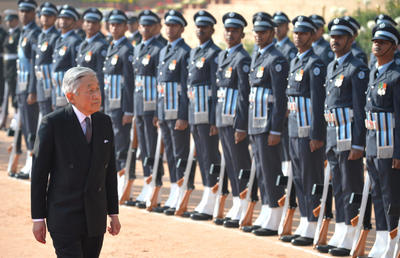In a rare break with protocol, Prime Minister Manmohan Singh and his wife received the Emperor and Empress at New Delhi’s Palam airport. In a further departure from protocol, the Indian foreign minister served as the royal couple’s ‘minister-in-waiting’ during their stay in the country.
The royal visit was as much a moment of high symbolism in bilateral relations as it is a testament to the determination of Prime Minister Shinzo Abe to realise an imperial visit to India. Abe has not been shy to imaginatively wield the Emperor’s immense appeal to advance his foremost political goal — that of ‘escaping the (US Occupation authority-imposed) post-war regime’, which he believes deprived Japan of national pride and weakened traditional mores.
Earlier last April, in the presence of Emperor Akihito, he quoted a tanka song composed by the late Showa Emperor in 1945 as he offered an oration to mark the first formal ceremony to commemorate the anniversary of Japan’s restoration of sovereignty in 1952. That the Prime Minister has now guided the Emperor to India (as well as a member of the imperial household to Buenos Aires to support Tokyo’s successful Olympics 2020 host city bid) attests to his desire to conjoin His Majesty’s formidable soft power to his foreign policy ends too.
India has long held a pride of place in Abe’s philosophical and strategic leanings. It is the land of the dissenting Bengali judge at the Tokyo War Crimes Trials whose verdict has been misrepresented and glorified by his revisionist constituencies in Tokyo. It is also a key peg in Abe’sfanciful schemes of arcs, crescents, quadrilaterals and diamonds designed to maintain the strategic peace in Asia. Whether the high symbolism of a royal visit will translate into commensurate bilateral strategic proximity remains to be seen.
Emperor Akihito and Empress Michiko are no strangers to India, having made a highly-publicised visit as Crown Prince and Princess during their honeymoon in 1960.
Beyond the palace, people-to-people ties too have left a lasting imprint in both countries. A century ago, Japanese and Indian artists and philosophers inaugurated a rich intellectual exchange on the idea of a reimagined Asia founded on the essential unity of the continent’s pluralist cultural and spiritual traditions (ASEAN’s principles of transparency, inclusiveness, equality and consensus-based decision-making derive in part today from these traditions). The jubilant reception to Japan’s victory in its war with Russia in 1905 was a confirmation of their belief of the universality of modernity — one that is accessible to, and attainable by, all races, colours and ethnicities. In time, this alternative discourse would contribute mightily to the process of decolonisation. Equally, as Japan’s own brand of pan-Asianism departed from this universalistic ethic and began to assert the cause of a supra-ethnic brotherhood of East Asian nations under the tutelage of Tokyo, this remarkable chapter of exchange was brought to a close.
It is worth bearing in mind though that palace visits and people-to-people ties never did distract the sitting government in Tokyo from pursuing its narrower national interests. Fidelity to the Anglo-Japanese alliance from 1902 to 1923 meant that arrest of Indian revolutionaries and deportation from Japan always took precedence over the ideal of Asian unity or racial justice for others in Tokyo. Prince Akihito and Prime Minister Ikeda’s visits in 1960 and 1961 (during which the latter observed that Japan and India were the natural pegs of a security system in Asia) never did deflect Tokyo from its stance of neutrality during the Sino-Indian border conflict of October–November 1962. The Ikeda government went so far as to inaugurate a quasi-official Japan-China trade channel — the so-called LT (Liao-Takasaki) trade— between the two phases of armed hostilities on the border.
Looking ahead, if an Indo-Japanese entente of shared purpose is to take shape in this forthcoming Asian century, it will need to again find inspiration in many of those far-sighted ideas championed a century ago.
Asia’s model of international relations might or might not hew to an ethic of pan-Asianism that espouses an alternative ideal of universal modernity, but it must never abandon its commitment to multilateralism and global civilisation.
Asia’s model of international relations might or might not be keyed to regional tradition and historical circumstance but its institutions, even as they are multi-layered, must never violate the ethos of equality and consensus. Asia’s model of international relations might or might not be constructed atop a contending balance of power but it must always resile from dubious legitimising doctrines that are zero-sum in character. Above all, legacies of pan-Asianism must serve as a basis for seamless and open-ended regional integration, not as a cloak for hegemony, containment, expansion or expulsion. Closed-ended strategic, economic, and trade blocs and alliances fundamentally do not comport with this vision; deepening such blocs and alliances represents Asia’s past, not its future.
Ever since 1871, the Emperor of Japan has seen no contradiction in wearing a western frock coat, military uniform or suit while at the same time being the historical manifestation of a timeless Japanese identity and spirit. If Abe’s ‘Broader Asia’ and India’s ‘Look East’ policies can be formulated with a similarly polytheistic amalgam of modernity that is rooted in regional tradition, the Emperor’s recent visit to New Delhi will go a small but significant way towards realising a shared purpose in Asia that has been lacking in the India-Japan relationship for much of the post-war period.
Sourabh Gupta is Senior Research Associate at Samuels International Associates, Inc. Washington DC.

